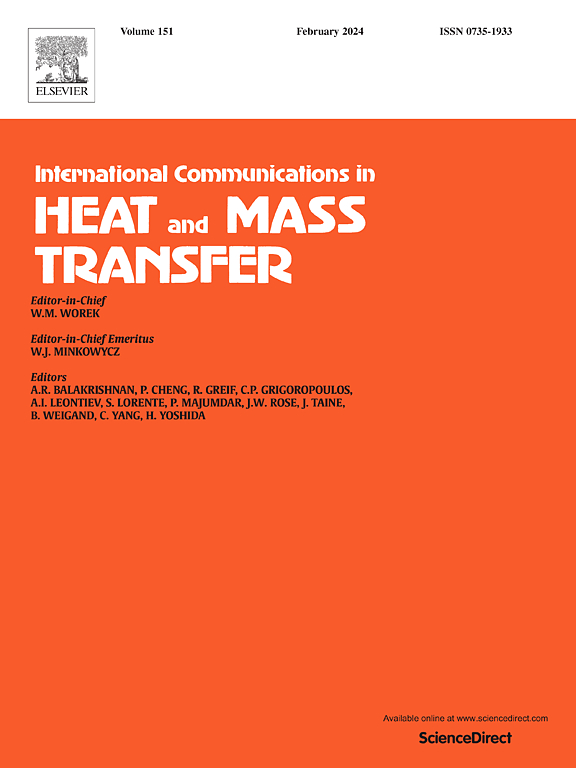亚/超临界共注氧水环境下煤的传热传质机理研究
IF 6.4
2区 工程技术
Q1 MECHANICS
International Communications in Heat and Mass Transfer
Pub Date : 2025-06-28
DOI:10.1016/j.icheatmasstransfer.2025.109268
引用次数: 0
摘要
利用亚/超临界水助注氧实验系统,在亚/超临界水共注氧环境下,对煤体内不同测点的温度进行实时监测。本文采用理论分析和数值模拟相结合的方法,研究了煤在亚/超临界共注入氧水环境下的传热传质机理。主要研究结果如下:首先,煤在亚/超临界水环境下与氧快速氧化的临界温度点为350℃。其次,不同位置的反应热在350℃以下没有变化,在临界点处急剧发散,在临界点以上仍有显著差异,对初始注氧温度的敏感性不大。第三,在与注水井等距离的位置中,注采井方向的位置在注氧过程中表现出明显更高的反应热量。此外,在350℃以下的亚临界水环境中,煤与氧之间发生广泛的不完全氧化,存在大量的残余氧。在350℃以上的超临界水环境中,氧化变得更加完全,几乎没有残余氧残留。最后,当煤在亚/超临界水环境中的温度超过临界温度350℃后,氧浓度随距离注入点的距离而显著变化。由于氧输运和氧化反应的共同作用,形成了三个顺序的区:完全氧化放热区、不完全氧化放热区和低氧浓度下的热解区。本文章由计算机程序翻译,如有差异,请以英文原文为准。
Study on the heat and mass transfer mechanisms of coal under sub-/supercritical water environment with co-injected oxygen
By utilizing a sub-/supercritical water-assisted oxygen injection experimental system, real-time temperature monitoring at different measurement points within the coal body is performed during the sub-/supercritical water environment with co-injected oxygen. Combined with theoretical analysis and numerical simulation, this study investigates the heat and mass transfer mechanisms of coal under sub-/supercritical water environment with co-injected oxygen. The main research findings are as follows: Firstly, the critical temperature point for rapid oxidation of coal with oxygen in a sub-/supercritical water environment is 350 °C. Secondly, reaction heat at different locations shows no variation below 350 °C, diverges sharply at the critical point, and remains significantly different above it with little sensitivity to initial oxygen injection temperature. Thirdly, among positions equidistant from the injection well, those along the injection-to-production well direction exhibit significantly higher reaction heat during oxygen injection. Furthermore, below 350 °C, extensive incomplete oxidation occurs between coal and oxygen in the subcritical water environment, with significant residual oxygen present. Above 350 °C, oxidation becomes more complete in the supercritical water environment, with little to no residual oxygen remaining. Finally, when the temperature of the coal in the sub-/supercritical water environment exceeds the critical temperature of 350 °C before oxygen injection, oxygen concentrations vary significantly with distance from the injection point. Due to the combined effects of oxygen transport and oxidation reactions, three sequential zones are formed: a fully oxidized exothermic zone, an incompletely oxidized exothermic zone, and a pyrolysis zone under low oxygen concentration.
求助全文
通过发布文献求助,成功后即可免费获取论文全文。
去求助
来源期刊
CiteScore
11.00
自引率
10.00%
发文量
648
审稿时长
32 days
期刊介绍:
International Communications in Heat and Mass Transfer serves as a world forum for the rapid dissemination of new ideas, new measurement techniques, preliminary findings of ongoing investigations, discussions, and criticisms in the field of heat and mass transfer. Two types of manuscript will be considered for publication: communications (short reports of new work or discussions of work which has already been published) and summaries (abstracts of reports, theses or manuscripts which are too long for publication in full). Together with its companion publication, International Journal of Heat and Mass Transfer, with which it shares the same Board of Editors, this journal is read by research workers and engineers throughout the world.

 求助内容:
求助内容: 应助结果提醒方式:
应助结果提醒方式:


